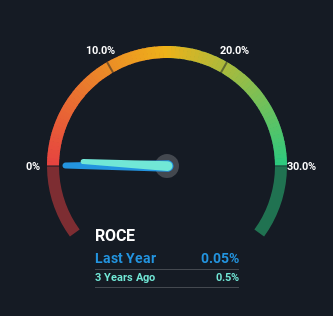- New Zealand
- /
- Healthcare Services
- /
- NZSE:RYM
Returns On Capital At Ryman Healthcare (NZSE:RYM) Paint A Concerning Picture

There are a few key trends to look for if we want to identify the next multi-bagger. One common approach is to try and find a company with returns on capital employed (ROCE) that are increasing, in conjunction with a growing amount of capital employed. Basically this means that a company has profitable initiatives that it can continue to reinvest in, which is a trait of a compounding machine. In light of that, when we looked at Ryman Healthcare (NZSE:RYM) and its ROCE trend, we weren't exactly thrilled.
Return On Capital Employed (ROCE): What Is It?
Just to clarify if you're unsure, ROCE is a metric for evaluating how much pre-tax income (in percentage terms) a company earns on the capital invested in its business. To calculate this metric for Ryman Healthcare, this is the formula:
Return on Capital Employed = Earnings Before Interest and Tax (EBIT) ÷ (Total Assets - Current Liabilities)
0.00047 = NZ$5.9m ÷ (NZ$13b - NZ$544m) (Based on the trailing twelve months to September 2023).
So, Ryman Healthcare has an ROCE of 0.05%. Ultimately, that's a low return and it under-performs the Healthcare industry average of 0.5%.
Check out our latest analysis for Ryman Healthcare

In the above chart we have measured Ryman Healthcare's prior ROCE against its prior performance, but the future is arguably more important. If you'd like to see what analysts are forecasting going forward, you should check out our free analyst report for Ryman Healthcare .
What Does the ROCE Trend For Ryman Healthcare Tell Us?
In terms of Ryman Healthcare's historical ROCE movements, the trend isn't fantastic. To be more specific, ROCE has fallen from 0.9% over the last five years. Although, given both revenue and the amount of assets employed in the business have increased, it could suggest the company is investing in growth, and the extra capital has led to a short-term reduction in ROCE. And if the increased capital generates additional returns, the business, and thus shareholders, will benefit in the long run.
In Conclusion...
While returns have fallen for Ryman Healthcare in recent times, we're encouraged to see that sales are growing and that the business is reinvesting in its operations. And there could be an opportunity here if other metrics look good too, because the stock has declined 60% in the last five years. As a result, we'd recommend researching this stock further to uncover what other fundamentals of the business can show us.
Ryman Healthcare does come with some risks though, we found 3 warning signs in our investment analysis, and 1 of those is significant...
While Ryman Healthcare may not currently earn the highest returns, we've compiled a list of companies that currently earn more than 25% return on equity. Check out this free list here.
New: AI Stock Screener & Alerts
Our new AI Stock Screener scans the market every day to uncover opportunities.
• Dividend Powerhouses (3%+ Yield)
• Undervalued Small Caps with Insider Buying
• High growth Tech and AI Companies
Or build your own from over 50 metrics.
Have feedback on this article? Concerned about the content? Get in touch with us directly. Alternatively, email editorial-team (at) simplywallst.com.
This article by Simply Wall St is general in nature. We provide commentary based on historical data and analyst forecasts only using an unbiased methodology and our articles are not intended to be financial advice. It does not constitute a recommendation to buy or sell any stock, and does not take account of your objectives, or your financial situation. We aim to bring you long-term focused analysis driven by fundamental data. Note that our analysis may not factor in the latest price-sensitive company announcements or qualitative material. Simply Wall St has no position in any stocks mentioned.
About NZSE:RYM
Ryman Healthcare
Develops, owns, and operates integrated retirement villages, rest homes, and hospitals for the older people in New Zealand and Australia.
Reasonable growth potential with mediocre balance sheet.
Similar Companies
Market Insights
Community Narratives



